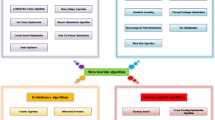Abstract
The artificial fish swarm algorithm can achieve good convergence effects in the early stage, but in the late stage, the algorithm has the problems of slow convergence speed and low optimization accuracy, and it is easy to fall into local extremes, making the algorithm’s convergence effect poor. Therefore, the characteristics of fireworks algorithm are used to improve the deficiency of fish swarm algorithm that is easy to fall into local extreme value in the late stage, and FWA-artificial fish swarm algorithm is put forward. When the effect of artificial fish swarm algorithm is poor, the explosion, mutation, mapping, and selection operations of fireworks algorithm are introduced to increase the variability of artificial fish, so as to enhance the optimization speed and ability of the algorithm. Finally, the improved algorithm is tested by four typical complex functions which are difficult to find the optimal solution by traditional method. Simulation results prove that the algorithm has the advantages of faster optimization speed, higher precision, and stronger stability.













Similar content being viewed by others
REFERENCES
Li, X., Shao, Z., and Qian, J., An optimizing method based on autonomous animals: fish swarm algorithm, Syst. Eng.: Theory Pract., 2002, vol. 22, no. 11, pp. 32–38.
Li, X. and Qian, J., Studies on artificial fish swarm optimization algorithm based on decomposition and coordination techniques, J. Circuits Syst., 2003, vol. 8, no. 1, pp. 1–6.
Qiu, Y. and Li, Z., An improved artificial fish swarm algorithm and its application for SVM parameter optimization, Comput. Eng. Sci., 2018, vol. 40, no. 11, pp. 2074–2079.
Neshat, M., Sepidnam, G., Sargolzaei, M., and Toosi, A.N., Artificial fish swarm algorithm: A survey of the state-of-the-art, hybridization, combinatorial and indicative applications, Artif. Intell. Rev., 2012, vol. 42, no. 4, pp. 965–997. https://doi.org/10.1007/s10462-012-9342-2
Luan, X., Liu, T., and Zhou, Z., LED color mixing design based on improved artificial fish swarm algorithm, Chin. J. Luminescence, 2015, vol. 36, no. 1, pp. 113–120.
Geng, C., Wang, F., Su, L., and Zhang, J., Parameter identification of Jiles–Atherton model for transformer based on hybrid artificial fish swarm and shuffled frog leaping algorithm, Proc. CSEE, 2015, vol. 35, no. 18, pp. 4799–4807.
Zhang, Yi, Guan, G., and Pang, D., Robot path planning method based on modified artificial fish swarm algorithm, Comput. Simul., 2016, vol. 33, no. 12, pp. 374–379.
Kong, D., Peng, H., and Ma, J., Adaptive stochastic resonance method based on artificial-fish swarm optimization, Acta Electron. Sinica, 2017, vol. 45, no. 8, pp. 1864–1872.
Zheng, W., Wen, X., Yang, W., and Yao, Y., Stochastic resonance weak signal detection based on hybrid intelligent algorithm, Comput. Simul., 2021, vol. 38, no. 6, pp. 469–474.
Wang, N., Dai, J., and Han, J., Strategy on target allocation of anti-tbm combat based on improved artificial fish-swarm algorithm, Fire Control Command Control, 2019, vol. 44, no. 4, pp. 65–68.
Mai, P., Research on anti-skid pid neural network control of vehicle based on artificial fish swarm algorithms, Chin. J. Constr. Mach.¸2020, vol. 18, no. 3, pp. 215–219.
Yang, X., Lv, H., and Zhu, H., Reconfiguration of distribution network based on improved artificial fish swarm algorithm, Electr. Meas. Instrum., 2020, vol. 57, no. 17, pp. 72–78.
Tan, Y. and Zhu, Y., Fireworks algorithm for optimization, Advances in Swarm Intelligence. ICSI 2010, Tan, Y., Shi, Y., and Tan, K.C., Eds., Lecture Notes in Computer Science, vol. 6145, Berlin: Springer, 2010, pp. 355–364. https://doi.org/10.1007/978-3-642-13495-1_44
Cao, L., Ye, Ch., and Huang, X., Applying chaotic fireworks algorithm in solving permutation flow shop problem, Comput. Appl. Software, 2016, vol. 33, no. 11, pp. 188–192.
Reddy, K.S., Panwar, L.K., Kumar, R., and Panigrahi, B.K., Distributed resource scheduling in smart grid with electric vehicle deployment using fireworks algorithm, J. Mod. Power Syst. Clean Energy, 2016, vol. 4, no. 2, pp. 188–199. https://doi.org/10.1007/s40565-016-0195-6
Xue, J., Wang, Y., Meng, X., and Xiao, J., Binary opposite backward learning fireworks algorithm for multidimensional knapsack problem, Syst. Eng. Electron., 2017, vol. 39, no. 2, pp. 451–458.
Zhang, W., Ma, Y., Zhao, H., Zhang, L., Li, Y., and Li, X., Obstacle avoidance path planning of intelligent mobile based on improved fireworks-ant colony hybrid algorithm, Control Decis., 2019, vol. 34, no. 2, pp. 335–343.
Mo, H., Zhao, Z., Zeng, M., Shi, J., and Wen, T., Hybrid bats and fireworks algorithm with adaptive step size and collaborative optimization, J. Chin. Comput. Syst., 2019, vol. 40, no. 7, pp. 1423–1429.
Cai, Y., Chen, H., and Qi, Y., Variable neighborhood quantum fireworks algorithm for solving CVRP, Comput. Eng. Appl., 2019, vol. 55, no. 9, pp. 230–236.
Xue, Y., Zhang, X., Zhang, G., and Jia, S., Path planning and smoothing based on quantum-behaved fireworks algorithm for mobile robot, Control Theory Appl., 2019, vol. 36, no. 9, pp. 1398–1408.
Liu, S., Gao, X., He, H., and Qi, W., Soft sensor modelling of acrolein conversion based on hidden markov model of principle component analysis and fireworks algorithm, Can. J. Chem. Eng., 2019, vol. 97, no. 12, pp. 3052–3062. https://doi.org/10.1002/cjce.23520
Zeng, M., Zhao, Z., and Li, Z., Self-learning improved fireworks algorithm with Cauchy mutation, J. Chin. Comput. Syst., 2020, vol. 41, no. 2, pp. 264–270.
Fei, T., Zhang, L., Bai, Y., and Chen, L., Improved artificial fish swarm algorithm based on DNA, J. Tianjin Univ. (Sci. Technol.), 2016, vol. 49, no. 6, pp. 581–588.
Wang, L. and Shi, Q., Parameters analysis of artificial fish swarm algorithm, Comput. Eng., 2010, vol. 36, no. 24, pp 169–171.
Zhu, X., Ni, Z., and Cheng, M., Self-adaptive improved artificial fish swarm algorithm with changing step, Comput. Sci., 2015, vol. 42, no. 2, pp. 210–216.
Author information
Authors and Affiliations
Corresponding author
Ethics declarations
The authors declare that they have no conflicts of interest.
About this article
Cite this article
Liyi Zhang, Fu, M., Fei, T. et al. The Artificial Fish Swarm Algorithm Improved by Fireworks Algorithm. Aut. Control Comp. Sci. 56, 311–323 (2022). https://doi.org/10.3103/S0146411622040101
Received:
Revised:
Accepted:
Published:
Issue Date:
DOI: https://doi.org/10.3103/S0146411622040101




